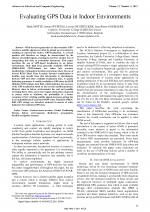| 3/2011 - 4 |
Evaluating GPS Data in Indoor EnvironmentsMOTTE, H. |
| Extra paper information in |
| Click to see author's profile in |
| Download PDF |
Author keywords
context-aware services, Global Positioning System, indoor environments, radiowave propagation, satellite navigation systems
References keywords
indoor(8), strycker(6), sensor(5), navigation(5), localization(5), goemaere(5), wyffels(4), networks(4), location(4), local(4)
Blue keywords are present in both the references section and the paper title.
About this article
Date of Publication: 2011-08-31
Volume 11, Issue 3, Year 2011, On page(s): 25 - 28
ISSN: 1582-7445, e-ISSN: 1844-7600
Digital Object Identifier: 10.4316/AECE.2011.03004
Web of Science Accession Number: 000296186700004
SCOPUS ID: 80055087410
Abstract
With the latest generation of ultra-sensitive GPS-receivers, satellite signals can often be picked up even indoors, resulting in (inaccurate) indoor GPS-localization. A covered position will therefore no longer be characterized by the absence of satellite signals, creating the need for another way of categorizing this data as potentially inaccurate. This paper describes the use of GPS-based localization in an indoor environment. Only high level, generally available, GPS-data (NMEA-0183 GNSS-subset) are taken into account. Applications of ubiquitous location awareness, where the use of several RTLS (Real Time Location System) combinations is feasible, may benefit from this information to discriminate between GPS and other available localization data. A quality indicating parameter is readily available in GPS-data; the DOP (Dilution Of Precision) data field, which indicates the accuracy of the GPS localization based on the current satellite geometry. However since in indoor environments the roof and possible overlying floors often cause more signal attenuation compared to (outer) walls or windows, the probability of a better reception of 'low' orbiting satellite signals increases, giving rise to an unjustified good horizontal DOP value. Standard NMEA-0183 GPS strings are therefore analyzed in search of other indicators for malicious GPS-data. |
| References | | | Cited By |
Web of Science® Times Cited: 4 [View]
View record in Web of Science® [View]
View Related Records® [View]
Updated 2 weeks, 6 days ago
SCOPUS® Times Cited: 13
View record in SCOPUS® [Free preview]
View citations in SCOPUS® [Free preview]
[1] From Coarse to Fine: Two-Stage Indoor Localization with Multisensor Fusion, Zhang, Li, Bao, Jinhui, Xu, Yi, Wang, Qiuyu, Xu, Jingao, Li, Danyang, Tsinghua Science and Technology, ISSN 1007-0214, Issue 3, Volume 28, 2023.
Digital Object Identifier: 10.26599/TST.2022.9010029 [CrossRef]
[2] Visible Light Positioning as a Next-Generation Indoor Positioning Technology: A Tutorial, Bastiaens, Sander, Alijani, Morteza, Joseph, Wout, Plets, David, IEEE Communications Surveys & Tutorials, ISSN 1553-877X, Issue 4, Volume 26, 2024.
Digital Object Identifier: 10.1109/COMST.2024.3372153 [CrossRef]
[3] Implementation of a WiFi-based indoor location system on a mobile device for a university area, Fernandez, Dennis Nunez, 2019 IEEE XXVI International Conference on Electronics, Electrical Engineering and Computing (INTERCON), ISBN 978-1-7281-3646-2, 2019.
Digital Object Identifier: 10.1109/INTERCON.2019.8853556 [CrossRef]
[4] DEVELOPMENT OF INDOOR POSITIONING SYSTEM, BASED ON LEAFLET MAP, GEOLOCATION AND WI-FI POSITION ESTIMATION WITH ACCURACY ASSESSMENT, Ilieva, Tamara, 23rd SGEM International Multidisciplinary Scientific GeoConference Proceedings 2023, Informatics, Geoinformatics and Remote Sensing, Vol 23, Issue 2.1., ISBN 9786197603576, Issue , 2023.
Digital Object Identifier: 10.5593/sgem2023/2.1/s08.21 [CrossRef]
[5] Semantics Indoor Navigation Using a Path Finding and Spatial Mapping for Assisting Visually Impaired Person, Asante, Bismark Kweku Asiedu, Imamura, Hiroki, 2024 Joint 13th International Conference on Soft Computing and Intelligent Systems and 25th International Symposium on Advanced Intelligent Systems (SCIS&ISIS), ISBN 979-8-3503-7333-2, 2024.
Digital Object Identifier: 10.1109/SCISISIS61014.2024.10760133 [CrossRef]
[6] Multi-Region Indoor Localization Based on WVP System, Zhang, Li, Xu, Yi, Bao, Jinhui, Wang, Qiuyu, Xu, Jingao, Li, Danyang, Yang, Yaodong, Zhang, Min, 2021 IEEE 27th International Conference on Parallel and Distributed Systems (ICPADS), ISBN 978-1-6654-0878-3, 2021.
Digital Object Identifier: 10.1109/ICPADS53394.2021.00102 [CrossRef]
[7] RSSI - WIFI Based Indoor Position Tracking System Using Support Vector Machine (SVM), Irsan, Ferdian A.S., Aminah, Nina Siti, Djamal, Mitra, 2022 International Conference on Electrical, Computer, Communications and Mechatronics Engineering (ICECCME), ISBN 978-1-6654-7095-7, 2022.
Digital Object Identifier: 10.1109/ICECCME55909.2022.9988134 [CrossRef]
Disclaimer: All information displayed above was retrieved by using remote connections to respective databases. For the best user experience, we update all data by using background processes, and use caches in order to reduce the load on the servers we retrieve the information from. As we have no control on the availability of the database servers and sometimes the Internet connectivity may be affected, we do not guarantee the information is correct or complete. For the most accurate data, please always consult the database sites directly. Some external links require authentication or an institutional subscription.
Web of Science® is a registered trademark of Clarivate Analytics, Scopus® is a registered trademark of Elsevier B.V., other product names, company names, brand names, trademarks and logos are the property of their respective owners.
Faculty of Electrical Engineering and Computer Science
Stefan cel Mare University of Suceava, Romania
All rights reserved: Advances in Electrical and Computer Engineering is a registered trademark of the Stefan cel Mare University of Suceava. No part of this publication may be reproduced, stored in a retrieval system, photocopied, recorded or archived, without the written permission from the Editor. When authors submit their papers for publication, they agree that the copyright for their article be transferred to the Faculty of Electrical Engineering and Computer Science, Stefan cel Mare University of Suceava, Romania, if and only if the articles are accepted for publication. The copyright covers the exclusive rights to reproduce and distribute the article, including reprints and translations.
Permission for other use: The copyright owner's consent does not extend to copying for general distribution, for promotion, for creating new works, or for resale. Specific written permission must be obtained from the Editor for such copying. Direct linking to files hosted on this website is strictly prohibited.
Disclaimer: Whilst every effort is made by the publishers and editorial board to see that no inaccurate or misleading data, opinions or statements appear in this journal, they wish to make it clear that all information and opinions formulated in the articles, as well as linguistic accuracy, are the sole responsibility of the author.



